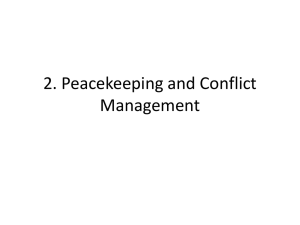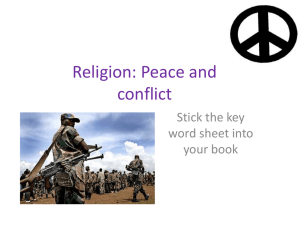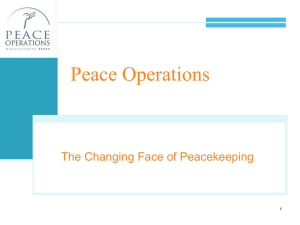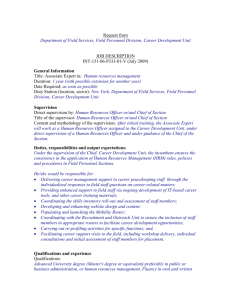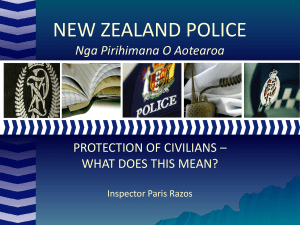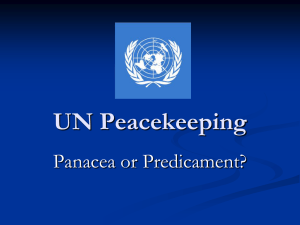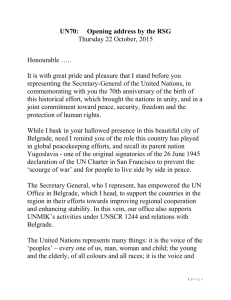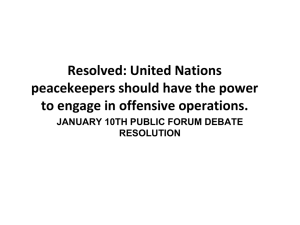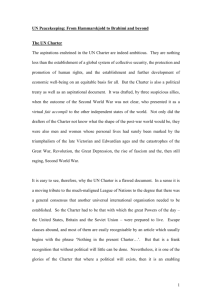Unit 6
advertisement
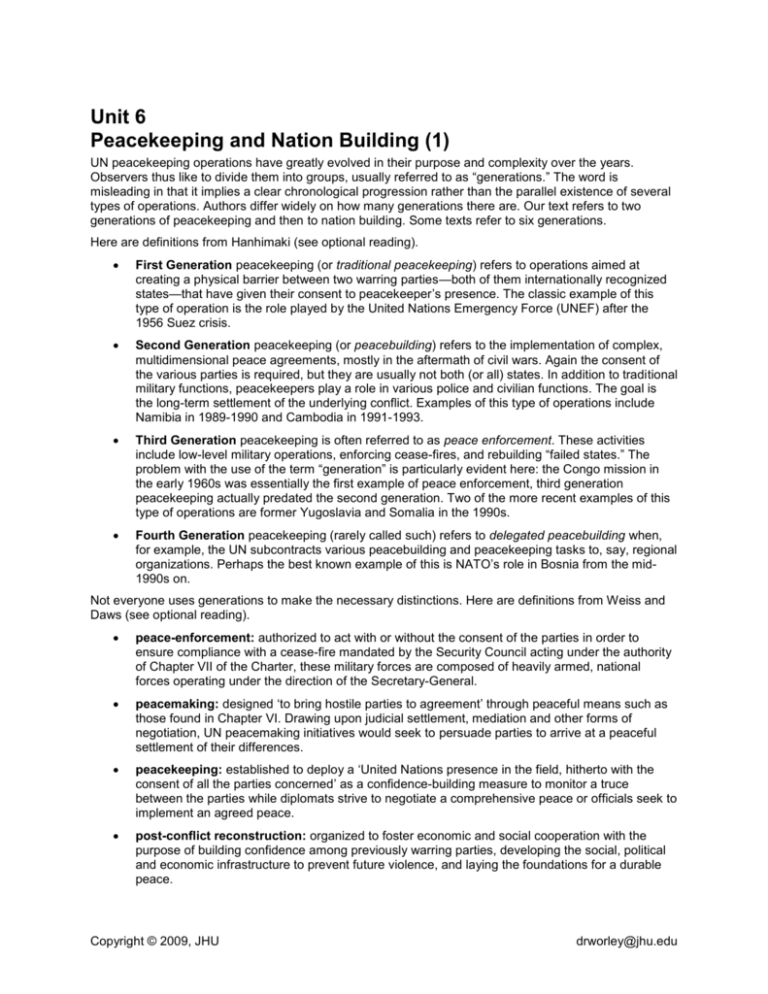
Unit 6 Peacekeeping and Nation Building (1) UN peacekeeping operations have greatly evolved in their purpose and complexity over the years. Observers thus like to divide them into groups, usually referred to as “generations.” The word is misleading in that it implies a clear chronological progression rather than the parallel existence of several types of operations. Authors differ widely on how many generations there are. Our text refers to two generations of peacekeeping and then to nation building. Some texts refer to six generations. Here are definitions from Hanhimaki (see optional reading). First Generation peacekeeping (or traditional peacekeeping) refers to operations aimed at creating a physical barrier between two warring parties—both of them internationally recognized states—that have given their consent to peacekeeper’s presence. The classic example of this type of operation is the role played by the United Nations Emergency Force (UNEF) after the 1956 Suez crisis. Second Generation peacekeeping (or peacebuilding) refers to the implementation of complex, multidimensional peace agreements, mostly in the aftermath of civil wars. Again the consent of the various parties is required, but they are usually not both (or all) states. In addition to traditional military functions, peacekeepers play a role in various police and civilian functions. The goal is the long-term settlement of the underlying conflict. Examples of this type of operations include Namibia in 1989-1990 and Cambodia in 1991-1993. Third Generation peacekeeping is often referred to as peace enforcement. These activities include low-level military operations, enforcing cease-fires, and rebuilding “failed states.” The problem with the use of the term “generation” is particularly evident here: the Congo mission in the early 1960s was essentially the first example of peace enforcement, third generation peacekeeping actually predated the second generation. Two of the more recent examples of this type of operations are former Yugoslavia and Somalia in the 1990s. Fourth Generation peacekeeping (rarely called such) refers to delegated peacebuilding when, for example, the UN subcontracts various peacebuilding and peacekeeping tasks to, say, regional organizations. Perhaps the best known example of this is NATO’s role in Bosnia from the mid1990s on. Not everyone uses generations to make the necessary distinctions. Here are definitions from Weiss and Daws (see optional reading). peace-enforcement: authorized to act with or without the consent of the parties in order to ensure compliance with a cease-fire mandated by the Security Council acting under the authority of Chapter VII of the Charter, these military forces are composed of heavily armed, national forces operating under the direction of the Secretary-General. peacemaking: designed ‘to bring hostile parties to agreement’ through peaceful means such as those found in Chapter VI. Drawing upon judicial settlement, mediation and other forms of negotiation, UN peacemaking initiatives would seek to persuade parties to arrive at a peaceful settlement of their differences. peacekeeping: established to deploy a ‘United Nations presence in the field, hitherto with the consent of all the parties concerned’ as a confidence-building measure to monitor a truce between the parties while diplomats strive to negotiate a comprehensive peace or officials seek to implement an agreed peace. post-conflict reconstruction: organized to foster economic and social cooperation with the purpose of building confidence among previously warring parties, developing the social, political and economic infrastructure to prevent future violence, and laying the foundations for a durable peace. Copyright © 2009, JHU drworley@jhu.edu There isn’t general agreement on these terms, so read the literature with caution. One of the distinctions generally made is whether there is a peace to keep or if peace must be made (whether to bring handguns or assault rifles). Another key distinction made is whether the conflict is between states (interstate) or within a state (intrastate). It may interest you to know that the cost when the “middle powers” (e.g., Pakistan) conduct PKO, is about one fifth the cost when “major powers” (e.g., the US) conduct PKO. The UN has established a Department of Peacekeeping Operations (DPKO) as the principal agency for PKO. Information on DPKO and PKO can be found at the URL below. The Brahami Report is often referred to in the literature. All should be aware of it and read its executive summary. Some of you may want to examine the full report. In this unit we discuss the general topic and in the next unit we turn to case studies. Required Reading New UN chapter 3 “Chapter VI 1/2 Provisions” p 81 New UN chapter 6 Peacekeeping and Nation Building Brahami Report at www.un.org/peace/reports/peace_operations (executive summary) UN Peacekeeping http://www.un.org/en/peacekeeping/ Optional Reading Brahami Report at www.un.org/peace/reports/peace_operations Jussi M. Hanhimaki. The United Nations: A Very Short Introduction (NY: Oxford University Press, 2008): 76-77. Thomas G. Weiss and Sam Daws, eds. The Oxford Handbook on the United Nations (NY: Oxford University Press, 2007): 324. Study Questions SQ1: Peacekeeping Forces. Which countries provide the actual forces for peacekeeping operations? What is the underlying logic behind this? Identify examples in the assigned reading. SQ2: Peacekeeping Funding. Which countries provide the funding for peacekeeping operations? What are the alternative proposals that have been made for funding peacekeeping? Consider the pros and cons of the various funding methods. SQ3: Measuring Success. These types of intervention are phenomenally complex. The root of the conflict can often be traced back centuries. Defining success in these interventions as peaceful resolution of the conflict seems quite unrealistic. How should success be measured? How successful is the UN in these types of interventions? SQ4: Charter Issues. The UN Charter is like the US Constitution in that the various member states gave a limited grant of authority to the larger body. (The Constitution creates a federation while the Charter creates a loose confederation.) The very fact that interventions beyond first generation are referred to as Chapter VI and a 1/2 suggests that modern PKO and nation building are beyond the UN’s authority. At a minimum, member states can claim that they are not obligated to pay or participate. Consider the pros and cons of making this type of intervention central to UN operations. Graded Activities Go to Discussion Forum and interact with your fellow students over the discussion questions. Copyright © 2009, JHU drworley@jhu.edu
